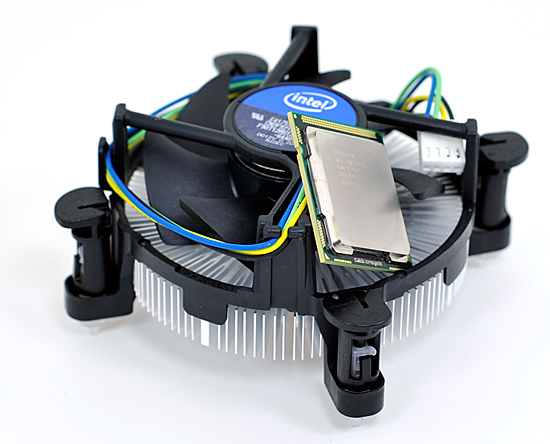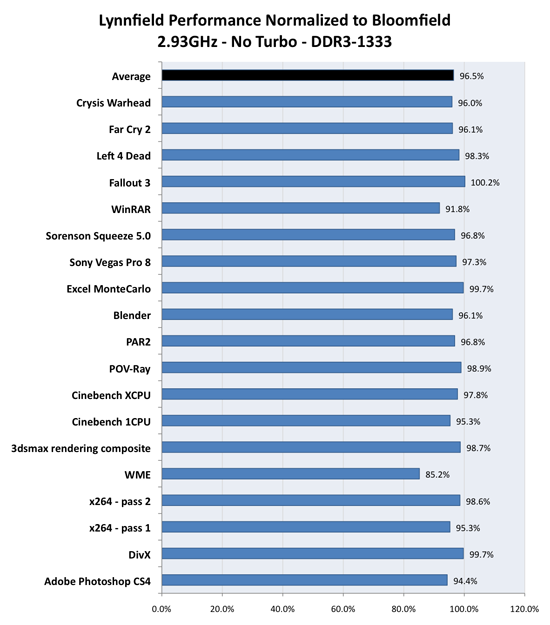The Lynnfield Followup: Turbo Mode and Overclocking Investigated
by Anand Lal Shimpi on September 18, 2009 12:00 AM EST- Posted in
- CPUs
When Lynnfield launched I was on the other side of the country talking GPUs. AMD rented out the USS Hornet to tempt press in and kept them captive for several hours while divulging details of its new DX11 GPUs, the RV770 successors.

Needless to say, while I could read your comments about Lynnfield and what you desired, there was little I could do about it while sitting on (er, in) an aircraft carrier. Gary did a wonderful job with his follow ups but they managed to delay his P55 motherboard reviews. As soon as I landed, it was straight to work on the Lynnfield followup and that's what I'm publishing today.

The first thing many of you asked for were turbo off results between Lynnfield and Bloomfield. On top of that, some wanted results with the exact same memory frequencies. Bloomfield officially only supports up to DDR3-1066, while Lynnfield's memory controller is validated for operation at up to DDR3-1333. Clearly both will work at speeds up to and beyond DDR3-2000, but for stock comparisons I've always tried to stay within validated limits of the platforms.
Below are our application benchmark results comparing Lynnfield to Bloomfield, with turbo disabled, and both platforms running DDR3-1333 at 7-7-7-20 timings. Unlike our standard test beds I've forced the CPUs into their highest performance mode so they are always running at 2.93GHz. The only difference between the two chips is that the Bloomfield is an underclocked Core i7 975 so its un-core runs at 2.66GHz compared to 2.40GHz for the Lynnfield. The real world impact of that difference is negligible:

On average, Lynnfield without turbo mode delivers 96.5% of the performance of Bloomfield. The extra memory controller of Bloomfield is responsible for a 3.5% performance advantage on average; it's just not going to do much at these clock speeds/core configurations.
There are exceptions to the rule. Some applications do benefit from Bloomfield's triple channel memory controller. We see a 15% difference in Windows Media Encoder and nearly a 10% difference in a few other applications. Ultimately it's up to you whether or not the performance difference is worth it, but enable turbo and the advantage clearly goes to Lynnfield as we showed in our initial review.










46 Comments
View All Comments
ClownPuncher - Monday, September 21, 2009 - link
Do all of your comments need insults in them? Take a Midol and stfu.Inkie - Saturday, September 19, 2009 - link
Uh, did you perhaps notice that these benchmarks were with turbo disabled at equal clocks? There haven't been any benchmarks that alter the standard story: most of the time going from 3ch to 2ch shows little benefit for most desktop users (or indeed using higher bandwidth memory...lots of articles showing this), compared to the benefit of higher clockspeed. Now, I know that you are going to reply with something about overclocking blah blah blah ad nauseum, but many users never overclock their CPUs. You know, serious users. I'd never use a computer seriously without ECC, but others do. If I wasn't planning to upgrade to 6-core or something and I didn't want a Xeon for ECC support, I'd certainly choose Ci7 on P55 over Ci7 on X58 for any kind of comparable price (which is what this release was really about: new price points for the performance on offer). That's without considering power consumption. You are just desperately trying to cling to your 'Bloomfield superiority'. Grow up.Inkie - Saturday, September 19, 2009 - link
Sorry, I meant going from 2ch to 3ch.C'DaleRider - Saturday, September 19, 2009 - link
Wish the teenage retard hiding behind his nick would just dry up and blow away.Proper memory? Hint: The Patriot Viper memory used in their testing is excellent memory and easily OC's to 1600 and beyond, but adimttedly you have to back off the CAS to 8 at 1600.
Get a life and when you move out of your parent's basement and get your own house, job, and life, just let us know.
By then, your teenage angst know-it-all attitude should have faded as it typically does for most adults.
TA152H - Saturday, September 19, 2009 - link
What are you talking about? Can you read, you sub-human dolt?What memory are you talking about?
My problem with Anand's testing, on other tests, was he would running PC 1066 on the Bloomfield, and PC 1333 on the Lynnfield.
If you were anything but a sub-hunan ape, you'd have understood that.
Zoomer - Saturday, September 19, 2009 - link
In theory, an on die PCIe controller would help performance by lowering CPU<->GPU communication latency.The reason why it's being bashed it because it limits max overclock freq and requires VCore to be turned up.
imsabbel - Saturday, September 19, 2009 - link
Even your beloved Bloomfield has an on-die memory controller.How the hell should your GPU access memory without going to through the CPU, genius?
Sagath - Saturday, September 19, 2009 - link
No.Simply put, he said on-die PCIe controller, not memory.
And he was stating that he thinks (and is looking for confirmation) that the PCIe controller (That thing that, you know, gives info to your PCIe slots?) uses the same bus as the on-die memory controller.
Thus if both your CPU AND GPU want information from memory, how do they prioritize it? Which controller gets to use the BUS first?
Try pulling your head out of your ass, and use some comprehension skills before insulting someone next time, genius.
Inkie - Saturday, September 19, 2009 - link
I think he was referring to this:"The x58 doesn't have to use the wider memory bus of the Bloomfield, so this problem doesn't exist"
He was merely stating that it doesn't matter if there is an intervening QPI connection: the GPU still needs to access the memory controller (for the kind of situations that TAH was talking about). I can't really see why Intel would use an inferior access solution for Lynnfield than it does for the Bloomfield/X58 combination.
Inkie - Saturday, September 19, 2009 - link
...unless someone is going to start talking about the number of PCIe lanes, but that is something that Anand has already talked about.